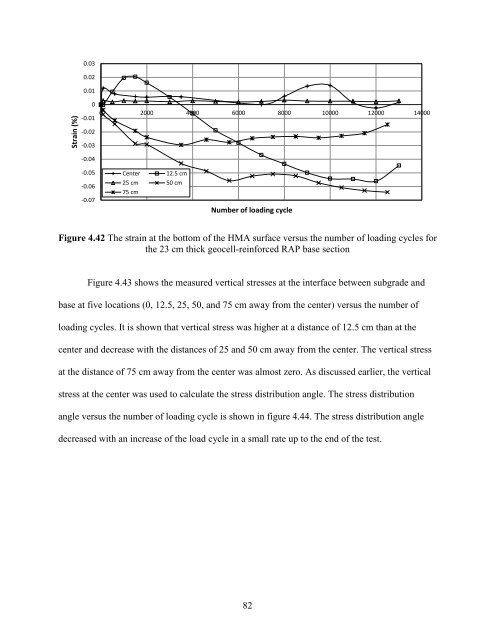Onsite Use of Recycled Asphalt Pavement Materials and Geocells to ...
Onsite Use of Recycled Asphalt Pavement Materials and Geocells to ...
Onsite Use of Recycled Asphalt Pavement Materials and Geocells to ...
Create successful ePaper yourself
Turn your PDF publications into a flip-book with our unique Google optimized e-Paper software.
Strain (%)<br />
0.03<br />
0.02<br />
0.01<br />
0<br />
-0.01<br />
-0.02<br />
-0.03<br />
-0.04<br />
-0.05<br />
-0.06<br />
-0.07<br />
0 2000 4000 6000 8000 10000 12000 14000<br />
Center 12.5 cm<br />
25 cm 50 cm<br />
75 cm<br />
Number <strong>of</strong> loading cycle<br />
Figure 4.42 The strain at the bot<strong>to</strong>m <strong>of</strong> the HMA surface versus the number <strong>of</strong> loading cycles for<br />
the 23 cm thick geocell-reinforced RAP base section<br />
Figure 4.43 shows the measured vertical stresses at the interface between subgrade <strong>and</strong><br />
base at five locations (0, 12.5, 25, 50, <strong>and</strong> 75 cm away from the center) versus the number <strong>of</strong><br />
loading cycles. It is shown that vertical stress was higher at a distance <strong>of</strong> 12.5 cm than at the<br />
center <strong>and</strong> decrease with the distances <strong>of</strong> 25 <strong>and</strong> 50 cm away from the center. The vertical stress<br />
at the distance <strong>of</strong> 75 cm away from the center was almost zero. As discussed earlier, the vertical<br />
stress at the center was used <strong>to</strong> calculate the stress distribution angle. The stress distribution<br />
angle versus the number <strong>of</strong> loading cycle is shown in figure 4.44. The stress distribution angle<br />
decreased with an increase <strong>of</strong> the load cycle in a small rate up <strong>to</strong> the end <strong>of</strong> the test.<br />
82
















